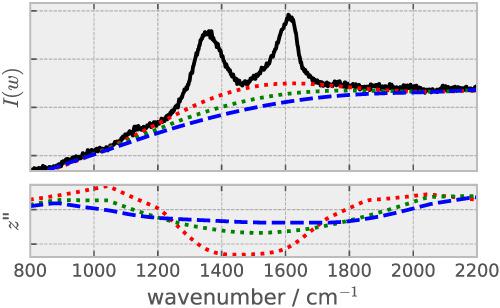当前位置:
X-MOL 学术
›
J. Raman Spectrosc.
›
论文详情
Our official English website, www.x-mol.net, welcomes your feedback! (Note: you will need to create a separate account there.)
Asymmetric least‐squares baseline algorithm with peak screening for automatic processing of the Raman spectra
Journal of Raman Spectroscopy ( IF 2.5 ) Pub Date : 2020-08-04 , DOI: 10.1002/jrs.5952 Vitaly I. Korepanov 1
Journal of Raman Spectroscopy ( IF 2.5 ) Pub Date : 2020-08-04 , DOI: 10.1002/jrs.5952 Vitaly I. Korepanov 1
Affiliation

|
The signal in Raman spectroscopy has three components: vibrational bands, noise, and luminescence. Although the noise can be easily separated from the Raman bands either by a variety of algorithms or by adjusting the measurement conditions, to distinguish between the luminescence and the Raman peaks is a challenging task. Even though a number of algorithms have been proposed for this purpose, most of them show poor performance when applied to broad overlapping Raman bands with extended tails. A practical example of such a case can be found in many carbon‐based nanoscale materials with some degree of disorder, where the two close‐lying D and G bands dominate the spectrum. Conventional asymmetric least‐squares algorithms generate a baseline with penalizing the second derivative of the baseline itself. Instead, the approach suggested in the present work is based on an assumption that the vibrational bands can be “detected” and “masked” by their first and second derivatives of the raw spectrum. This makes it possible to handle the broad tails and superimposed bands very efficiently. The proposed algorithm was compared to several state‐of‐the‐art approaches including original and recently proposed ALS implementations, wavelet‐transform, and morphological algorithms. The “quality” of different algorithms was quantitatively estimated by adding random smooth curves to the spectrum. It was found that among the tested approaches, the peak‐screened ALS algorithm shows the best separation of the broad superimposed Raman peaks from the smooth random baselines. The Python code of the algorithm is provided.
中文翻译:

具有峰筛选的非对称最小二乘基线算法可自动处理拉曼光谱
拉曼光谱中的信号具有三个分量:振动带,噪声和发光。尽管可以通过多种算法或通过调整测量条件轻松地将噪声与拉曼频带分离,但要区分发光峰和拉曼峰是一项艰巨的任务。尽管已经为此目的提出了许多算法,但是当应用于具有扩展尾巴的宽重叠拉曼波段时,大多数算法都表现不佳。在许多具有某种程度的无序性的碳基纳米级材料中都可以找到这种情况的实际例子,其中两个接近的D和G谱带占主导地位。常规的非对称最小二乘算法会生成基线,并对基线本身的二阶导数进行惩罚。代替,本工作中建议的方法基于这样一个假设:振动带可以被原始谱的一阶和二阶导数“检测”和“掩盖”。这使得可以非常有效地处理宽尾巴和叠加带。将该算法与几种最新方法进行了比较,包括原始和最近提出的ALS实现,小波变换和形态学算法。通过将随机平滑曲线添加到频谱,定量估算了不同算法的“质量”。结果发现,在经过测试的方法中,峰筛选ALS算法显示出宽广的叠加拉曼峰与平滑随机基线的最佳分离。提供了该算法的Python代码。
更新日期:2020-10-11
中文翻译:

具有峰筛选的非对称最小二乘基线算法可自动处理拉曼光谱
拉曼光谱中的信号具有三个分量:振动带,噪声和发光。尽管可以通过多种算法或通过调整测量条件轻松地将噪声与拉曼频带分离,但要区分发光峰和拉曼峰是一项艰巨的任务。尽管已经为此目的提出了许多算法,但是当应用于具有扩展尾巴的宽重叠拉曼波段时,大多数算法都表现不佳。在许多具有某种程度的无序性的碳基纳米级材料中都可以找到这种情况的实际例子,其中两个接近的D和G谱带占主导地位。常规的非对称最小二乘算法会生成基线,并对基线本身的二阶导数进行惩罚。代替,本工作中建议的方法基于这样一个假设:振动带可以被原始谱的一阶和二阶导数“检测”和“掩盖”。这使得可以非常有效地处理宽尾巴和叠加带。将该算法与几种最新方法进行了比较,包括原始和最近提出的ALS实现,小波变换和形态学算法。通过将随机平滑曲线添加到频谱,定量估算了不同算法的“质量”。结果发现,在经过测试的方法中,峰筛选ALS算法显示出宽广的叠加拉曼峰与平滑随机基线的最佳分离。提供了该算法的Python代码。

























 京公网安备 11010802027423号
京公网安备 11010802027423号